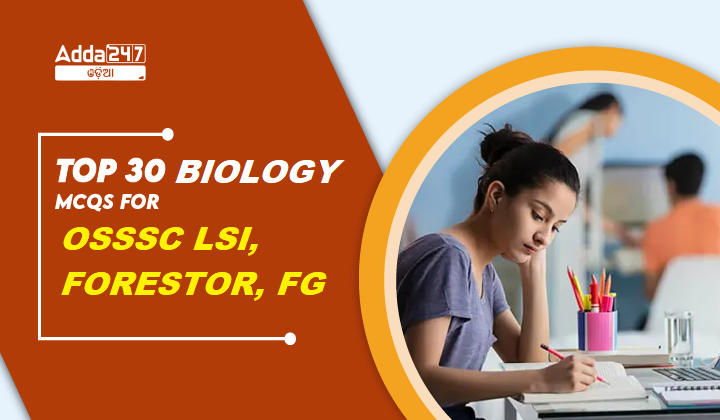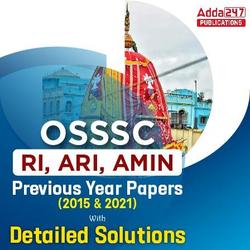The OSSSC LSI, Forester, or FG exams and seeking comprehensive preparation in Biology. We’ve compiled a curated list of the top 30 Biology (General Science) multiple-choice questions (MCQs) to aid in your exam readiness. Covering various aspects of biology, these questions delve into fundamental concepts, principles, and terminologies essential for success in your examination. Whether you’re focusing on cell biology, genetics, ecology, or physiology, this collection ensures a well-rounded understanding of the subject matter. With detailed explanations accompanying each answer, you’ll not only assess your knowledge but also enhance your understanding of key biological concepts. So, dive into these MCQs and embark on your journey towards acing the biology section of your OSSSC exams!
Top 30 Biology (General Science) MCQs for OSSSC LSI, Forester, FG
- Which of the following cellular processes involves communication between cells using extracellular signaling molecules?
a) Photosynthesis
b) DNA replication
c) Cell signaling
d) Protein synthesis
Answer: c) Cell signaling - Which of the following types of signaling is involved in the transmission of nerve impulses across synapses?
a) Endocrine signaling
b) Autocrine signaling
c) Synaptic signaling
d) Paracrine signaling
Answer: c) Synaptic signaling - Which of the following cell signaling molecules is NOT a neurotransmitter?
a) Dopamine
b) Serotonin
c) Insulin
d) Acetylcholine
Answer: c) Insulin - In multicellular organisms, what type of signaling involves the release of hormones into the bloodstream to act on distant target cells?
a) Endocrine signaling
b) Paracrine signaling
c) Autocrine signaling
d) Juxtacrine signaling
Answer: a) Endocrine signaling - What is the term for the process by which a cell responds to a signaling molecule by changing its behavior or gene expression?
a) Signal transduction
b) Signal amplification
c) Signal reception
d) Signal termination
Answer: a) Signal transduction - Which of the following is NOT a component of a typical G-protein-coupled receptor (GPCR)?
a) Seven transmembrane alpha-helices
b) G-protein binding site
c) Kinase domain
d) Ligand-binding site
Answer: c) Kinase domain - What is the function of second messengers in cell signaling pathways?
a) They bind to cell surface receptors
b) They amplify the original signal
c) They regulate G-proteins
d) They terminate the signaling cascade
Answer: b) They amplify the original signal - Which of the following is NOT a type of cell surface receptor?
a) Enzyme-linked receptor
b) Ion-channel linked receptor
c) G-protein linked receptor
d) Intracellular receptor
Answer: d) Intracellular receptor - Which of the following signaling molecules is NOT involved in immune responses?
a) Interferon
b) Histamine
c) Insulin
d) Cytokines
Answer: c) Insulin - Which organelle is responsible for the production of steroid hormones?
a) Golgi apparatus
b) Endoplasmic reticulum
c) Mitochondria
d) Nucleus
Answer: b) Endoplasmic reticulum - Which of the following statements is true regarding endocrine signaling?
a) It involves communication between adjacent cells.
b) It relies on neurotransmitters as signaling molecules.
c) It requires direct physical contact between cells.
d) It involves the release of hormones into the bloodstream to act on distant target cells.
Answer: d) It involves the release of hormones into the bloodstream to act on distant target cells. - Which of the following molecules is NOT derived from arachidonic acid?
a) Leukotrienes
b) Prostaglandins
c) Thromboxanes
d) Corticosteroids
Answer: d) Corticosteroids - How many transmembrane alpha-helices are typically present in G-protein coupled receptors (GPCRs)?
a) Two
b) Four
c) Seven
d) Ten
Answer: c) Seven - Steroids, a class of biologically active organic compounds, are derived from which precursor molecule?
a) Glucose
b) Cholesterol
c) Amino acids
d) Triglycerides
Answer: b) Cholesterol - Which of the following signaling molecules is primarily used in simple nerve reflexes?
a) Neurotransmitters
b) Cytokines
c) Steroids
d) Growth factors
Answer: a) Neurotransmitters - What is the primary function of G proteins in cell signaling?
a) They amplify the original signal.
b) They activate second messenger pathways.
c) They regulate gene expression.
d) They bind directly to DNA.
Answer: b) They activate second messenger pathways. - Which of the following is NOT a type of cell surface receptor?
a) Enzyme-linked receptor
b) G protein-coupled receptor
c) Intracellular receptor
d) Ion-channel linked receptor
Answer: c) Intracellular receptor - In multicellular organisms, cell signaling primarily involves communication through which of the following means?
a) Hormones
b) Neurotransmitters
c) Extracellular signaling molecules
d) Intracellular signaling molecules
Answer: a) Hormones - The hormone, also known as the ligand, is considered as the ________.
a) First messenger
b) Second messenger
c) Third messenger
d) Primary messenger
Answer: a) First messenger - Which of the following hormones typically requires a cell surface receptor for its action?
a) Estrogen
b) Thyroid hormone
c) Testosterone
d) Insulin
Answer: d) Insulin - What is Amflora, developed by BASF Plant Science, genetically modified to produce?
[A] Vitamin C
[B] Amylopectin
[C] Protein
[D] Lipids
Answer: B [Amylopectin] - Which crop is Amflora, also known as EH92-527-1, associated with?
[A] Rice
[B] Potato
[C] Wheat
[D] Corn
Answer: B [Potato] - What is the primary purpose of developing Amflora?
[A] Enhanced flavor
[B] Increased yield
[C] Resistance to pests
[D] Production of specific natural starch for industrial applications
Answer: D [Production of specific natural starch for industrial applications] - What is the normal human blood pressure reading?
[A] 110/110
[B] 120/70
[C] 120/80
[D] 140/60
Answer: C [120/80] - Which number in a blood pressure reading represents the systolic pressure?
[A] The first number
[B] The second number
[C] Both numbers
[D] None of the numbers
Answer: A [The first number] - What does the systolic pressure measure?
[A] The force exerted against the artery walls during a heartbeat
[B] The force exerted against the artery walls during rest
[C] The force exerted against the artery walls during breathing
[D] The force exerted against the artery walls during exercise
Answer: A [The force exerted against the artery walls during a heartbeat] - What does the diastolic pressure measure?
[A] The force exerted against the artery walls during a heartbeat
[B] The force exerted against the artery walls during rest
[C] The force exerted against the artery walls during breathing
[D] The force exerted against the artery walls during exercise
Answer: B [The force exerted against the artery walls during rest] - What unit is used to measure blood pressure?
[A] Pascal
[B] Millimeters of mercury (mmHg)
[C] Atmosphere (atm)
[D] Kilopascal (kPa)
Answer: B [Millimeters of mercury (mmHg)] - Which type of cell is capable of developing into any other type of cell?
[A] Endothelial
[B] Endodermal
[C] Stem
[D] None of the above
Answer: C [Stem] - What unique ability do stem cells possess?
[A] They can only develop into one specific type of cell
[B] They cannot differentiate into different cell types
[C] They have the potential to develop into any type of cell
[D] They can only develop into non-functional cells
Answer: C [They have the potential to develop into any type of cell]
















